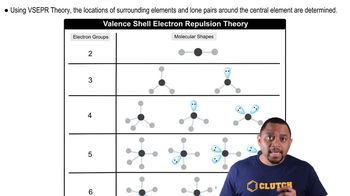Open Question
Sketch the antibonding molecular orbital that results from the linear combination of two 1s orbitals. Indicate the region where interference occurs and state the type of interference (constructive or destructive).
 Tro 5th Edition
Tro 5th Edition Ch.11 - Chemical Bonding II: Molecular Shapes, VSEPR & MO Theory
Ch.11 - Chemical Bonding II: Molecular Shapes, VSEPR & MO Theory Problem 34c
Problem 34c
 Verified step by step guidance
Verified step by step guidance



A molecule with the formula AB3 has a trigonal pyramidal geometry. How many electron groups are on the central atom (A)?
A molecule with the formula AB3 has a trigonal planar geometry. How many electron groups are on the central atom?
Determine the electron geometry, molecular geometry, and idealized bond angles for each molecule. In which cases do you expect deviations from the idealized bond angle? a. PF3 b. SBr2 c. CHCl3 d. CS2
Determine the electron geometry, molecular geometry, and idealized bond angles for each molecule. In which cases do you expect deviations from the idealized bond angle? a. CF4 b. NF3 c. OF2 d. H2S
Which species has the smaller bond angle, H3O+ or H2O? Explain.